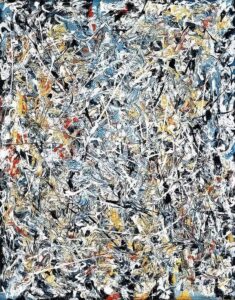

Jackson Pollock: Master of Abstract Expressionism
Jackson Pollock, a titan in the realm of modern art, revolutionized the way art is perceived and created. His contributions to the art world have left an indelible mark, making him one of the most significant artists in history. Pollock’s foray into abstract expressionism not only shattered traditional artistic norms but also paved the way for new explorations in art. His unique approach and experimental techniques birthed masterpieces that continue to captivate and inspire.
The Life and Art of Jackson Pollock
Jackson Pollock was born in 1912 in Cody, Wyoming, and grew up in a series of small towns in Arizona and California. The youngest of five sons, Pollock was exposed to Native American culture during his childhood, an influence that would later manifest in his work.
Early Career and Influences
- Pollock’s early career was marked by struggles with alcoholism and a search for his artistic identity. Influenced by his mentor, Thomas Hart Benton, and later by the Mexican muralist David Alfaro Siqueiros, Pollock experimented with various styles before arriving at his signature drip technique.
The Development of Drip Painting
- Pollock’s most significant contribution to the art world was his development of the drip painting technique. This method involved dripping, flinging, and pouring paint onto large canvases laid on the floor. This technique allowed him to be more physically involved in the act of painting, often using sticks, trowels, and even his hands instead of traditional brushes.
Autumn Rhythm and Other Masterpieces
Among Pollock’s numerous works, “Autumn Rhythm” stands out as a quintessential example of his genius. Created in 1950, this masterpiece epitomizes the rhythmic, dynamic style for which Pollock is famous.
The Essence of “Autumn Rhythm”
- “Autumn Rhythm” is characterized by its lack of a central focus, its all-over composition, and its rhythmic energy. The painting’s complex web of drips and splatters is a visual representation of Pollock’s physical dance around the canvas, a process he described as being in a trance-like state.
Other Notable Works
- Pollock’s other significant works, including “Blue Poles,” “Number 1 (Lavender Mist),” and “Convergence,” each represent milestones in his artistic journey. These paintings showcase his evolution in technique and his increasing comfort with abstract expressionism.
Pollock’s Impact on Modern Art
Jackson Pollock’s influence on modern art is vast and multifaceted. He not only changed the way artists approach the canvas but also challenged the viewer’s understanding of art.
Breaking Free from Traditional Techniques
- Pollock’s rejection of traditional painting techniques and his embrace of abstraction was revolutionary. His style encouraged artists to view the canvas as an arena to express their innermost feelings and to break free from the constraints of figurative representation.
Inspiring a Generation of Artists
- Pollock’s work inspired a generation of artists to experiment with new materials and techniques. His impact was felt not just in painting but in other art forms, including sculpture, installation art, and performance art.
The Legacy of Jackson Pollock
Jackson Pollock’s legacy is as complex and dynamic as his paintings. His life, marked by fame, controversy, and personal struggles, ended abruptly in a car accident in 1956. However, his influence on the art world endures.
Enduring Influence in Art and Culture
- Pollock’s techniques and approach to art-making continue to inspire artists around the world. His work has been referenced in various aspects of popular culture, including film, music, and literature, attesting to his lasting impact.
Critical Reception and Scholarly Analysis
- The critical reception of Pollock’s work has evolved over time. Initially met with skepticism and even derision, his paintings are now revered as groundbreaking masterpieces. Art historians and scholars continue to study his work, offering new interpretations and insights into his artistic genius.
Conclusion: Jackson Pollock’s Timeless Contributions
Jackson Pollock’s contributions to the art world transcended the boundaries of traditional art-making. His innovative techniques, particularly his development of drip painting, ushered in a new era of artistic expression. “Autumn Rhythm” and his other masterpieces are not merely paintings; they are vibrant, dynamic manifestations of emotion and creativity.
Pollock’s influence extends beyond his artworks to his innovative ideas, which continue to shape modern art. His enduring significance in the art world is a testament to his extraordinary vision and creativity. As an icon of abstract expressionism, Jackson Pollock remains a source of inspiration and admiration, a pioneer who challenged the norms and opened the doors to a world of artistic possibilities.
